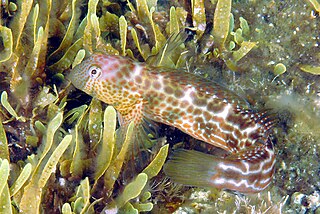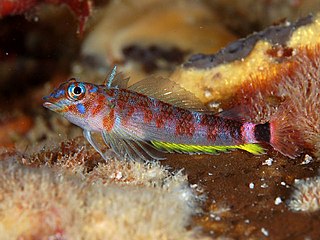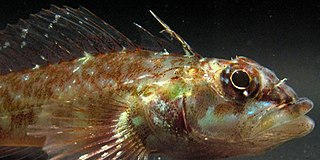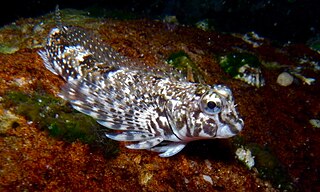
Anadoras weddellii is a species of thorny catfish that is found in Argentina, Brazil, Bolivia and Paraguay. This species grows to a length of 15.0 centimetres (5.9 in) SL. The IUCN Red List considers Anadoras regani a junior synonym of Anadoras weddellii, but FishBase and the Catalog of Fishes regard it as valid.

Istiblennius is a genus of combtooth blennies found in the Pacific and Indian Oceans. The generic name is a compound noun composed of istio the Greek for "sail", referring to the high dorsal fin of the type species, Istiblennius muelleri, and blennius which is derived from a word for "mucus" and refers to the scaleless bodies that characterise the Blenniidae.

Microlipophrys canevae is a species of combtooth blenny found in the northeast Atlantic Ocean near Portugal and in the Mediterranean Sea. This species grows to a length of 7.5 centimetres (3.0 in) TL.
Omobranchus woodi, the kappie blenny, is a species of combtooth blenny found in the southeast Atlantic and western Indian Ocean.
Rhabdoblennius is a genus of combtooth blennies found in the Pacific Ocean, mostly in the western Pacific. The name of this genus is derived from the Greek word rhabdos meaning "stick" or "rod" and blennius meaning "mucus", referring to the absence of scales on the body of blennies.

Emblemariopsis diaphana, the glass blenny, is a species of chaenopsid blenny found in coral reefs in the Florida Keys, USA, in the western central Atlantic ocean. It can reach a maximum length of 4 centimetres (1.6 in) TL. The specific name refers to this species being "largely translucent" in life, although this is lost in preserved specimens. E. diaphana is the type species of the genus Emblemariopsis.

Enneapterygius mirabilis, the miracle triplefin, is a species of triplefin blenny in the genus Enneapterygius. It was described by Ronald Fricke in 1994 who gave it the specific name mirabilis, meaning "admirable", because its notable large pectoral fins and first dorsal fin were pretty.
Enneapterygius namarrgon, the lightning man triplefin, is a species of triplefin blenny in the genus Enneapterygius. It was described by the German ichthyologist Ronald Fricke in 1997. The specific name refers to Namarrgon, the Lightning man who makes lightning appear and creates roars of thunder in storms, a mythical figure in western Arnhem Land, as does the common name. This species is endemic to the Gove Peninsula in Arnhem Land in the Northern Territory. The IUCN classifies this species as Endangered because it has a small range and is threatened by mining for bauxite.

Enneapterygius senoui is a species of triplefin blenny in the genus Enneapterygius. It was described by Hiroyuki Motomura, Shigeru Harazaki and Graham S. Hardy in 2005. The specific name honours Hiroshi Senou of the Kanagawa Prefectural Museum of Natural History, the collector of the holotype and four of the paratypes, making them available for study by the authors. It is found in the western Pacific Ocean off the Izu Islands and the Ogasawara Islands off southern Japan.
Enneapterygius williamsi, known commonly as the William's triplefin, is a species of triplefin blenny in the genus Enneapterygius. It was described by Ronald Fricke in 1997. Its specific name honours the collector of the type, the ichthyologist Jeffrey T. Williams of the Smithsonian Institution.
The red-eye threefin is a species of triplefin blenny in the genus Helcogramma. It was described by Albert William Herre in 1944 who honoured the Scottish naturalist and ethnologist Walter Elliot (1803-1897) in its specific name. This species occurs in the Indian Ocean along the eastern and western coasts of India and around Sri Lanka.

Hudson's triplefin is a species of triplefin blenny in the genus Helcogramma. It was described by David Starr Jordan and Alvin Seale in 1906, the specific name honouring the illustrator of their monograph on Samoan fishes, R.L. Hudson. This species is found in the western Pacific Ocean where it has been recorded from the Izu Islands, Ryukyu Islands, Savo Island, New Caledonia, Vanuatu, Fiji, and Samoa.
Helcogramma randalli, Randall's triplefin, is a species of triplefin blenny in the genus Helcogramma. It was described by Jeffrey T. Williams and Jeffrey C. Howe in 2003 and named it in honour of the ichthyologist John Ernest Randall of the Bishop Museum in Honolulu who collected all of the known specimens. This species occurs in the western Pacific Ocean and is endemic to the islands of central Indonesia such as Bali, Lombok, Timor and Komodo.

Helcogramma steinitzi, known commonly as the red triplefin, is a species of triplefin blenny in the genus Helcogramma. It was described by Eugenie Clark in 1980. The specific name honours the marine biologist and herpetologist Heinz Steinitz (1909-1971) of the Hebrew University, Jerusalem. This species occurs in the north western Indian Ocean from the Red Sea to the Persian Gulf.
Cunningham's triplefin is a species of triplefin blenny in the genus Helcogrammoides. It was described by Frederik Adam Smitt in 1898, who named it in honour the Scottish naturalist Robert Oliver Cunningham (1841-1918), who had collected specimens of this fish from Puerto Madryn in 1868 but was unable to identify them. This species has been found in Peru, near Lima, Chile, Puerto Madryn in Argentina and the Falkland Islands.

The eastern jumping blenny is a species of triplefin blenny in the genus Lepidoblennius. It was described by Franz Steindachner in 1867 and is the type species of the genus Lepidoblennius.
Matanui is a genus of triplefin blennies, they are endemic to New Zealand.
Brockius is a genus of labrisomid blennies from the waters of the eastern Pacific and the western Atlantic where they are associated with reefs and seaweed-covered rocks.

The saddleback gunnel, also known as the saddled blenny, is a species of marine ray-finned fish belonging to the family Pholidae, the gunnels. This fish occurs in the shallow coastal waters of the eastern North Pacific Ocean.

Pholis is a genus of marine ray-finned fish belonging to the family Pholidae, the gunnels. These fishes are found in shallow coastal waters of the North Pacific, Arctic and North Atlantic Oceans.











